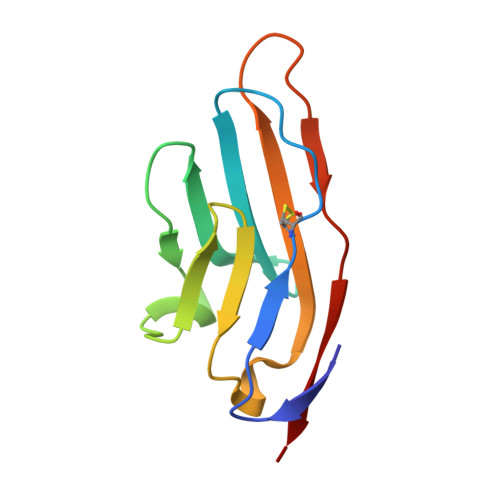Discovery and Analysis of Invertebrate IgVJ-C2 Structure from Amphioxus Provides Insight into the Evolution of the Ig Superfamily.
Chen, R., Zhang, L., Qi, J., Zhang, N., Zhang, L., Yao, S., Wu, Y., Jiang, B., Wang, Z., Yuan, H., Zhang, Q., Xia, C.(2018) J Immunol 200: 2869-2881
- PubMed: 29514951
- DOI: https://doi.org/10.4049/jimmunol.1700906
- Primary Citation of Related Structures:
5XPV, 5XPW - PubMed Abstract:
The emergence of adaptive immunity in jawed vertebrates depended on the appearance of variable immune receptors, BCRs and TCRs, which exhibit variable-J-constant (V J -C)-type Ig superfamily folds. Hitherto, however, the structures of IgV-J-IgC-type molecules had never been characterized in invertebrates, leaving the origin of BCR/TCR-type molecules unknown. Using x-ray crystallography, the structure of a V J -C2 molecule, named AmpIgV J -C2, was determined in amphioxus ( Branchiostoma floridae ). The first domain shows typical V folding, including the hydrophobic core, CDR analogs, and eight conserved residues. The second domain is a C2-type Ig superfamily domain, as defined by its short length and the absence of β-strand D- and C1-typical motifs. AmpIgV J -C2 molecules form homodimers, using "three-layer packing dimerization," as described for TCRs and BCRs. The AmpIgV J -C2 V domain harbors a diglycine motif in β-strand G and forms a β-bulge structure participating in V-V intermolecular interaction. By immunohistochemistry, AmpIgV J -C2 molecules were primarily found in mucosal tissues, whereas PCR and sequence analysis indicated considerable genetic variation at the single-gene level; these findings would be consistent with an immune function and a basic ability to adapt to binding different immune targets. Our results show a BCR/TCR-ancestral like molecule in amphioxus and help us to understand the evolution of the adaptive immune system.
Organizational Affiliation:
Department of Microbiology and Immunology, College of Veterinary Medicine, China Agricultural University, Haidian District, Beijing 100094, China.














